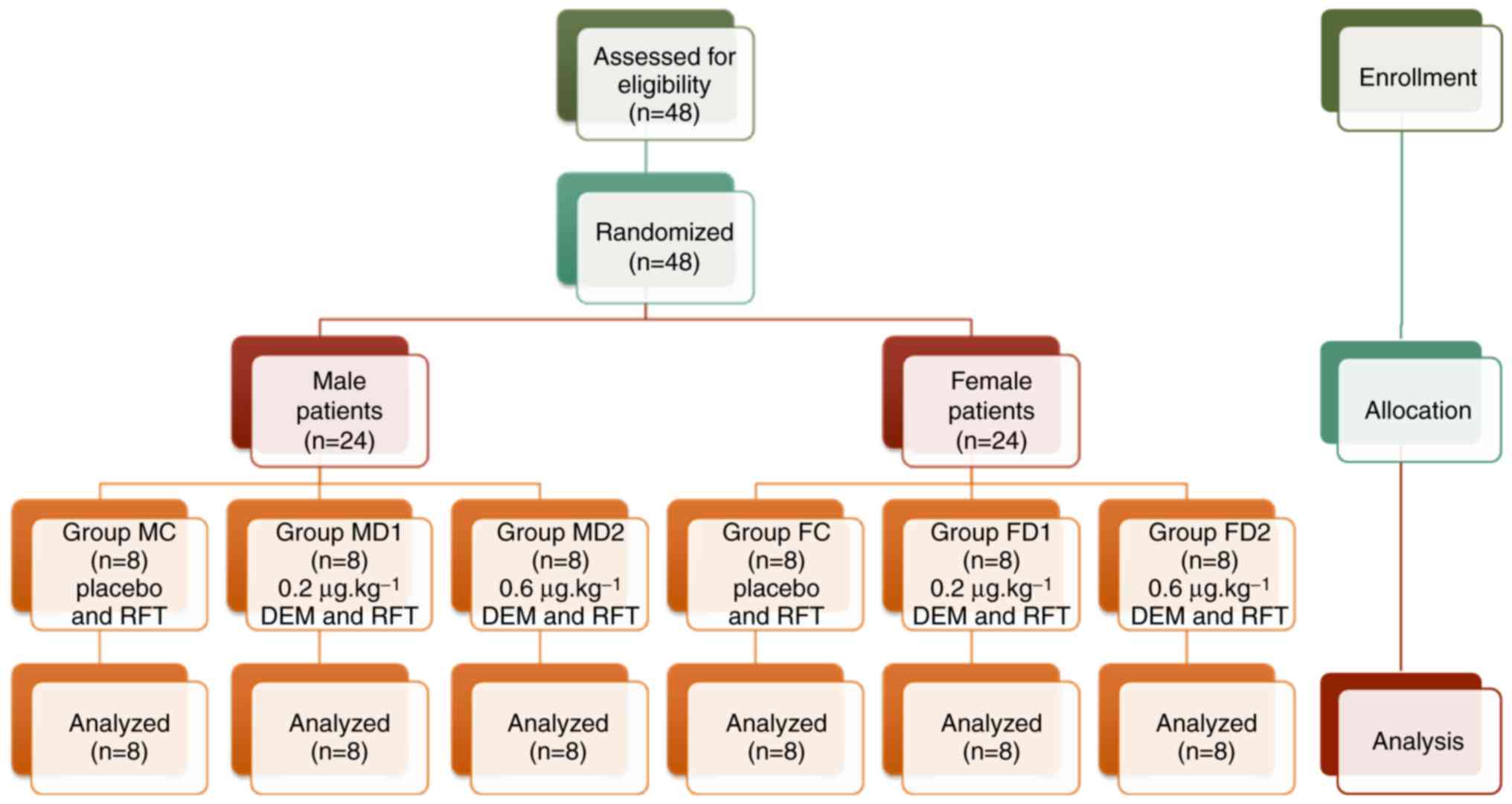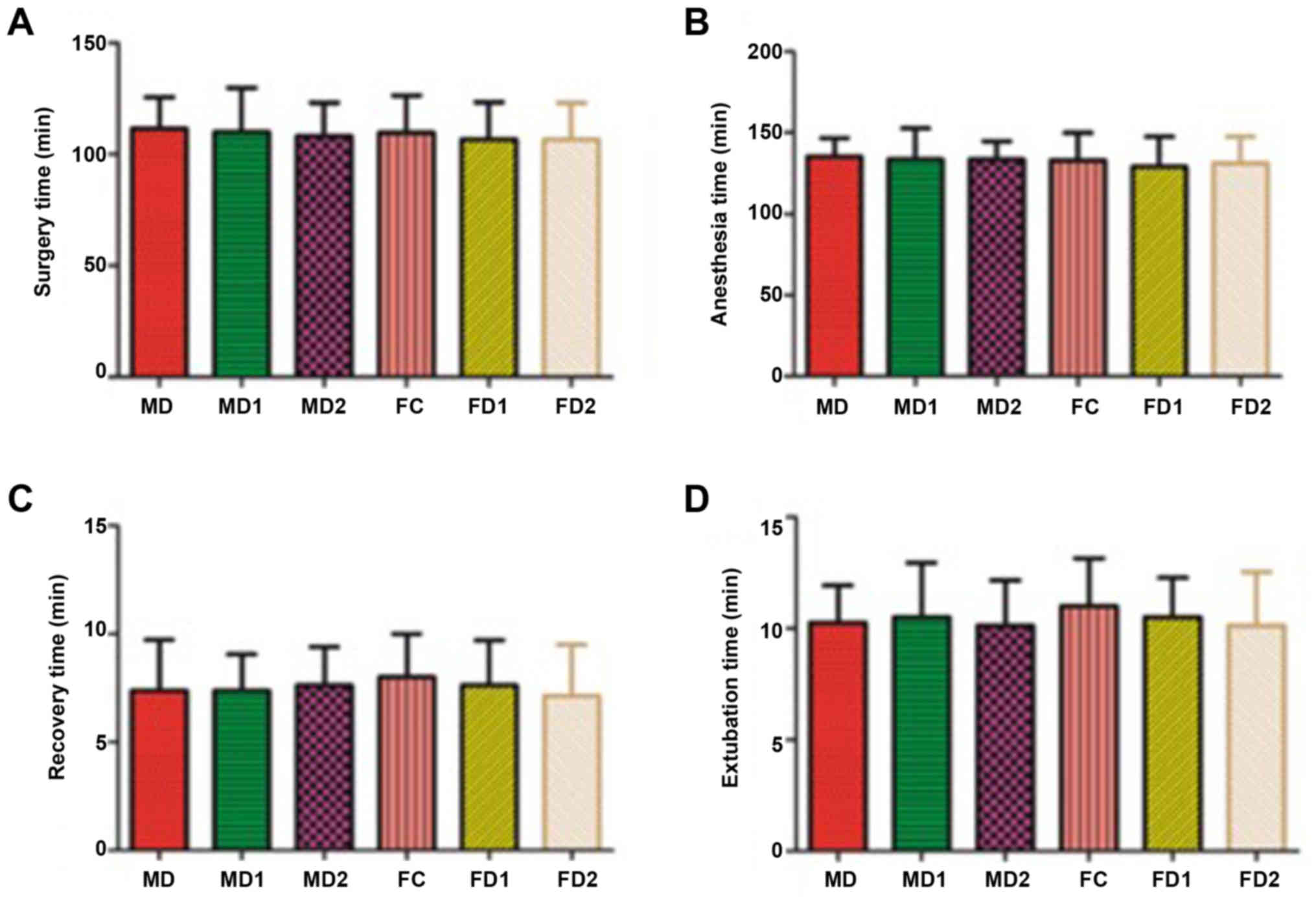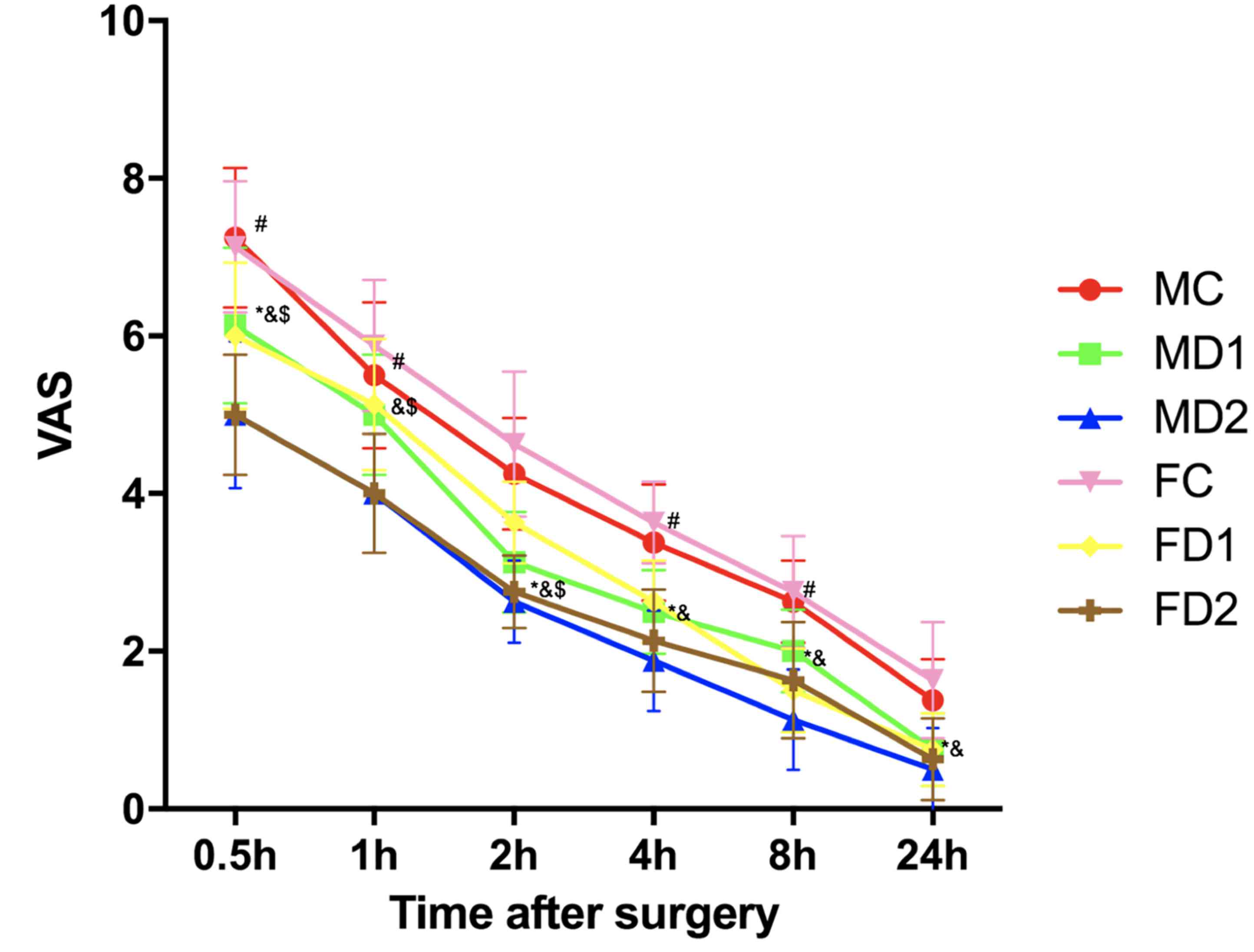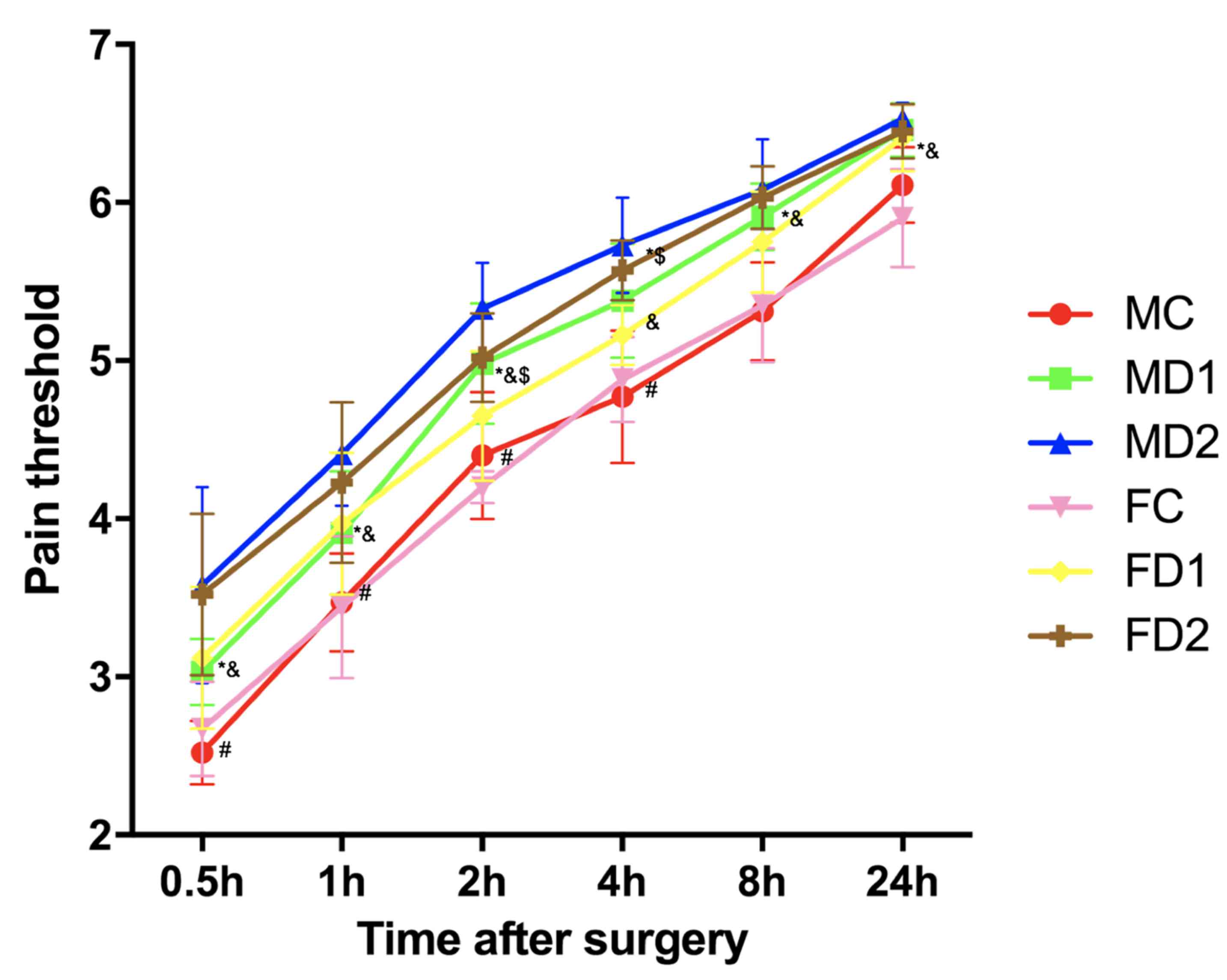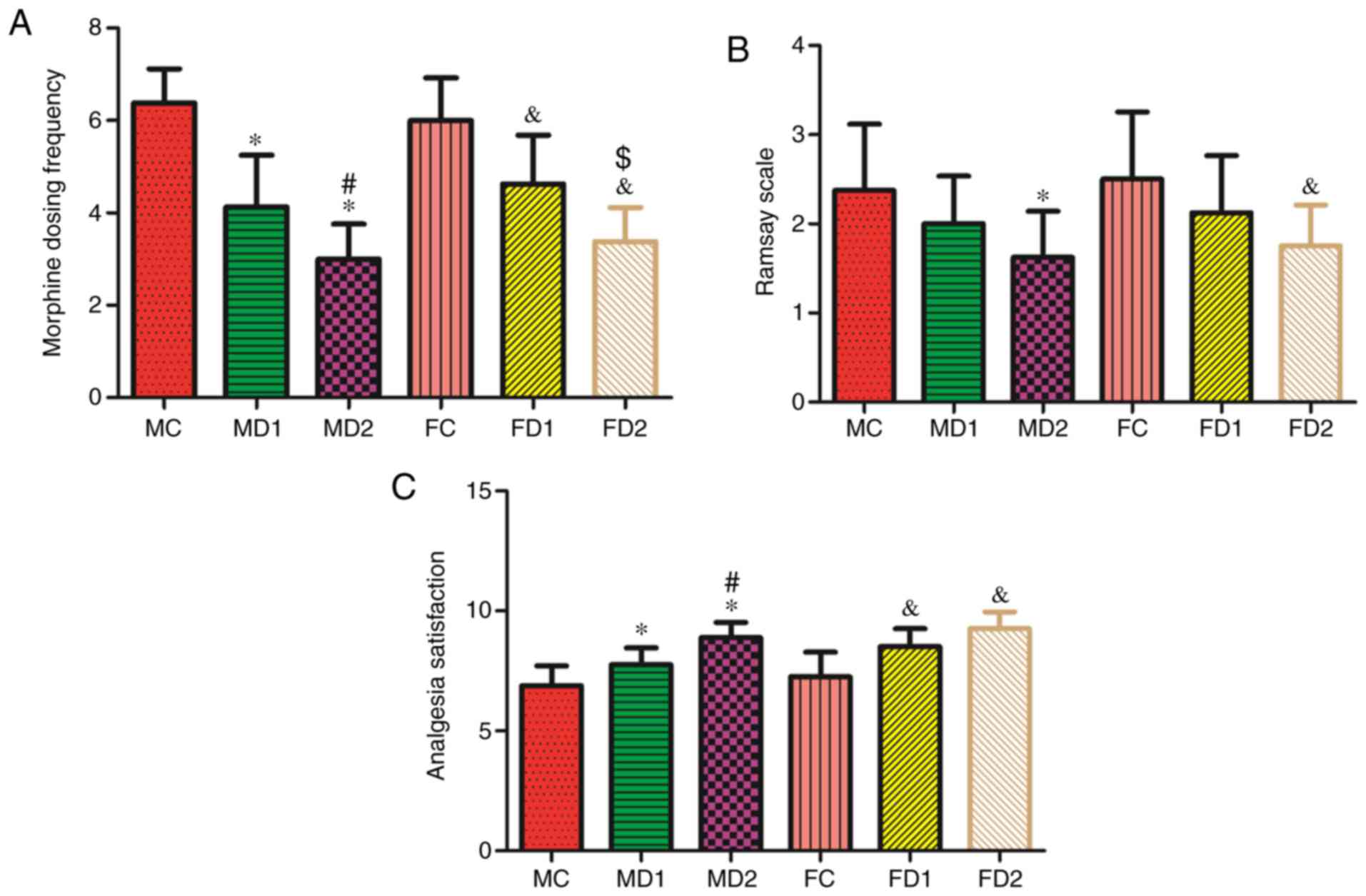|
1
|
Egan TD: Remifentanil pharmacokinetics and
pharmacodynamics. A preliminary appraisal. Clin Pharmacokinet.
29:80–94. 1995. View Article : Google Scholar : PubMed/NCBI
|
|
2
|
Yu EH, Tran DH, Lam SW and Irwin MG:
Remifentanil tolerance and hyperalgesia: Short-term gain, long-term
pain? Anaesthesia. 71:1347–1362. 2016. View Article : Google Scholar : PubMed/NCBI
|
|
3
|
Kim SH, Stoicea N, Soghomonyan S and
Bergese SD: Remifentanil-acute opioid tolerance and opioid-induced
hyperalgesia: A systematic review. Am J Ther. 22:e62–e74. 2015.
View Article : Google Scholar : PubMed/NCBI
|
|
4
|
Belgrade M and Hall S: Dexmedetomidine
infusion for the management of opioid-induced hyperalgesia. Pain
Med. 11:1819–1826. 2010. View Article : Google Scholar : PubMed/NCBI
|
|
5
|
Ge DJ, Qi B, Tang G and Li JY:
Intraoperative dexmedetomidine promotes postoperative analgesia and
recovery in patients after abdominal hysterectomy: A double-blind,
randomized clinical trial. Sci Rep. 6:215142016. View Article : Google Scholar : PubMed/NCBI
|
|
6
|
Joly V, Richebe P, Guignard B, Fletcher D,
Maurette P, Sessler DI and Chauvin M: Remifentanil-induced
postoperative hyperalgesia and its prevention with small-dose
ketamine. Anesthesiology. 103:147–155. 2005. View Article : Google Scholar : PubMed/NCBI
|
|
7
|
Yalcin N, Uzun ST, Reisli R, Borazan H and
Otelcioglu S: A comparison of ketamine and paracetamol for
preventing remifentanil induced hyperalgesia in patients undergoing
total abdominal hysterectomy. Int J Med Sci. 9:327–333. 2012.
View Article : Google Scholar : PubMed/NCBI
|
|
8
|
Choi E, Lee H, Park HS, Lee GY, Kim YJ and
Baik HJ: Effect of intraoperative infusion of ketamine on
remifentanil-induced hyperalgesia. Korean J Anesthesiol.
68:476–480. 2015. View Article : Google Scholar : PubMed/NCBI
|
|
9
|
Lenz H, Raeder J, Draegni T, Heyerdahl F,
Schmelz M and Stubhaug A: Effects of COX inhibition on experimental
pain and hyperalgesia during and after remifentanil infusion in
humans. Pain. 152:1289–1297. 2011. View Article : Google Scholar : PubMed/NCBI
|
|
10
|
Tröster A, Sittl R, Singler B, Schmelz M,
Schüttler J and Koppert W: Modulation of remifentanil-induced
analgesia and postinfusion hyperalgesia by parecoxib in humans.
Anesthesiology. 105:1016–1023. 2006. View Article : Google Scholar : PubMed/NCBI
|
|
11
|
Comelon M, Raeder J, Stubhaug A, Nielsen
CS, Draegni T and Lenz H: Gradual withdrawal of remifentanil
infusion may prevent opioid-induced hyperalgesia. Br J Anaesth.
116:524–530. 2016. View Article : Google Scholar : PubMed/NCBI
|
|
12
|
Sheehy KA, Finkel JC, Darbari DS, Guerrera
MF and Quezado ZM: Dexmedetomidine as an adjuvant to analgesic
strategy during vaso-occlusive episodes in adolescents with
sickle-cell disease. Pain Pract. 15:E90–E97. 2015. View Article : Google Scholar : PubMed/NCBI
|
|
13
|
Kamibayashi T and Maze M: Clinical uses of
alpha2-adrenergic agonists. Anesthesiology. 93:1345–1349. 2000.
View Article : Google Scholar : PubMed/NCBI
|
|
14
|
Zhang X and Bai Z: New therapeutic uses
for an alpha2 adrenergic receptor agonist-dexmedetomidine in pain
management. Neurosci Lett. 561:7–12. 2014. View Article : Google Scholar : PubMed/NCBI
|
|
15
|
Blaudszun G, Lysakowski C, Elia N and
Tramèr MR: Effect of perioperative systemic α2 agonists on
postoperative morphine consumption and pain intensity: Systematic
review and meta-analysis of randomized controlled trials.
Anesthesiology. 116:1312–1322. 2012. View Article : Google Scholar : PubMed/NCBI
|
|
16
|
Gold MS, Dastmalchi S and Levine JD: Alpha
2 adrenergic receptor subtypes in rat dorsal root and superior
cervical ganglion neurons. Pain. 69:179–190. 1997. View Article : Google Scholar : PubMed/NCBI
|
|
17
|
Lee M, Silverman SM, Hansen H, Patel VB
and Manchikanti L: A comprehensive review of opioid-induced
hyperalgesia. Pain Physician. 14:145–161. 2011.PubMed/NCBI
|
|
18
|
Zhong WG, Ge XY, Zhu H, Liang X, Gong HX,
Zhong M and Xiao X: Dexmedetomidine for antiemesis in gynecologic
surgery: A meta-analysis of randomized controlled trials. Int J
Clin Exp Med. 8:14566–14576. 2015.PubMed/NCBI
|
|
19
|
Jin S, Liang DD, Chen C, Zhang M and Wang
J: Dexmedetomidine prevent postoperative nausea and vomiting on
patients during general anesthesia: A PRISMA-compliant meta
analysis of randomized controlled trials. Medicine (Baltimore).
96:e57702017. View Article : Google Scholar : PubMed/NCBI
|
|
20
|
Bajwa SJ, Gupta S, Kaur J, Singh A and
Parmar S: Reduction in the incidence of shivering with
perioperative dexmedetomidine: A randomized prospective study. J
Anaesthesiol Clin Pharmacol. 28:86–91. 2012. View Article : Google Scholar : PubMed/NCBI
|
|
21
|
Kumar A, Shinha C, Kumar A and Kumari P:
The effect of intravenous dexmedetomidine compared to propofol on
patients hemodynamics as a sedative in brachial plexus block: A
comparative study. Anesth Essays Res. 11:201–205. 2017. View Article : Google Scholar : PubMed/NCBI
|
|
22
|
Fletcher D and Martinez V: How can we
prevent opioid induced hyperalgesia in surgical patients? Br J
Anaesth. 116:447–449. 2016. View Article : Google Scholar : PubMed/NCBI
|
|
23
|
Gu X, Wu X, Liu Y, Cui S and Ma Z:
Tyrosine phosphorylation of the N-Methyl-D-Aspartate receptor 2B
subunit in spinal cord contributes to remifentanil-induced
postoperative hyperalgesia: The preventive effect of ketamine. Mol
Pain. 5:762009. View Article : Google Scholar : PubMed/NCBI
|
|
24
|
Ye L, Xiao L, Bai X, Yang SY, Li Y and
Chen Y, Cui Y and Chen Y: Spinal mitochondrial-derived ROS
contributes to remifentanil-induced postoperative hyperalgesia via
modulating NMDA receptor in rats. Neurosci Lett. 634:79–86. 2016.
View Article : Google Scholar : PubMed/NCBI
|
|
25
|
Sun J, Lin H, He G, Lin W and Yang J:
Magnesium sulphate attenuate remifentanil-induced postoperative
hyperalgesia via regulating tyrosine phosphorylation of the
NR2B subunit of the NMDA receptor in the spinal cord.
BMC Anesthesiol. 17:302017. View Article : Google Scholar : PubMed/NCBI
|
|
26
|
Angst MS, Koppert W, Pahl I, Clark DJ and
Schmelz M: Short-term infusion of the µ-opioid agonist remifentanil
in humans causes hyperalgesia during withdrawal. Pain. 106:49–57.
2003. View Article : Google Scholar : PubMed/NCBI
|
|
27
|
Oladosu FA, Conrad MS, O'buckley SC,
Rashid NU, Slade GD and Nackley AG: Mu Opioid Splice Variant MOR-1K
Contributes to the Development of Opioid-Induced Hyperalgesia. PLoS
One. 10:e01357112015. View Article : Google Scholar : PubMed/NCBI
|
|
28
|
Vanderah TW, Gardell LR, Burgess SE,
Ibrahim M, Dogrul A, Zhong CM, Zhang ET, Malan TP Jr, Ossipov MH,
Lai J and Porreca F: Dynorphin promotes abnormal pain and spinal
opioid antinoceceptive tolerance. J Neurosci. 20:7074–7079. 2000.
View Article : Google Scholar : PubMed/NCBI
|
|
29
|
Jensen KB, Lonsdorf TB, Schalling M, Kosek
E and Ingvar M: Increased sensitivity to thermal pain following a
single opiate dose is influenced by the COMT val(158)met
polymorphism. PLoS One. 4:e60162009. View Article : Google Scholar : PubMed/NCBI
|
|
30
|
Youssef F, Pater A and Shehata M:
Opioid-induced hyperalgesia. J Pain Relief. 4:1832015.
|
|
31
|
Li A, Yuen VM, Goulay-Dufay S and Kwok PC:
Pharmacokinetics and pharmacodynamics of dexmedetomidine. Drug Dev
Ind Pharm. 42:1917–1927. 2016. View Article : Google Scholar : PubMed/NCBI
|
|
32
|
Yuan Y, Sun Z, Chen Y, Zheng Y, Xie KL, He
Y, Wang Z, Wang GL and Yu YH: Prevention of remifentanil induced
postoperative hyperalgesia by dexmedetomidine via regulation the
trafficking and function of spinal NMDA receptors as well as PKC
and CaMKII level in vivo and in vitro. PLoS One. 12:e01713482017.
View Article : Google Scholar : PubMed/NCBI
|
|
33
|
Fairbanks CA, Kitto KF, Nguyen HO, Stone
LS and Wilcox GL: Clonidine and dexmedetomidine produce
antinociceptive synergy in mouse spinal cord. Anesthesiology.
110:638–647. 2009. View Article : Google Scholar : PubMed/NCBI
|
|
34
|
Fairbanks CA, Stone LS, Kitto KF, Nguyen
HO, Posthumus IJ and Wilcox GL: α2c-adrenergic receptors mediate
spinal analgesia and adrenergic-opioid synergy. J Pharmacol Exp
Ther. 300:282–290. 2001. View Article : Google Scholar
|
|
35
|
Lee C, Kim YD and Kim JN: Antihyperalgesic
effects of dexmedetomidine on high-dose remifentanil-induced
hyperalgesia. Korean J Anesthesiol. 64:301–307. 2013. View Article : Google Scholar : PubMed/NCBI
|
|
36
|
Yu Z, Wu W, Wu X, Lei H, Gong C and Xu S:
Protective effects of dexmedetomidine combined with flurbiprofen
axetil on remifentanil-induced hyperalgesia: A randomized
controlled trial. Exp Ther Med. 12:2622–2628. 2016. View Article : Google Scholar : PubMed/NCBI
|















